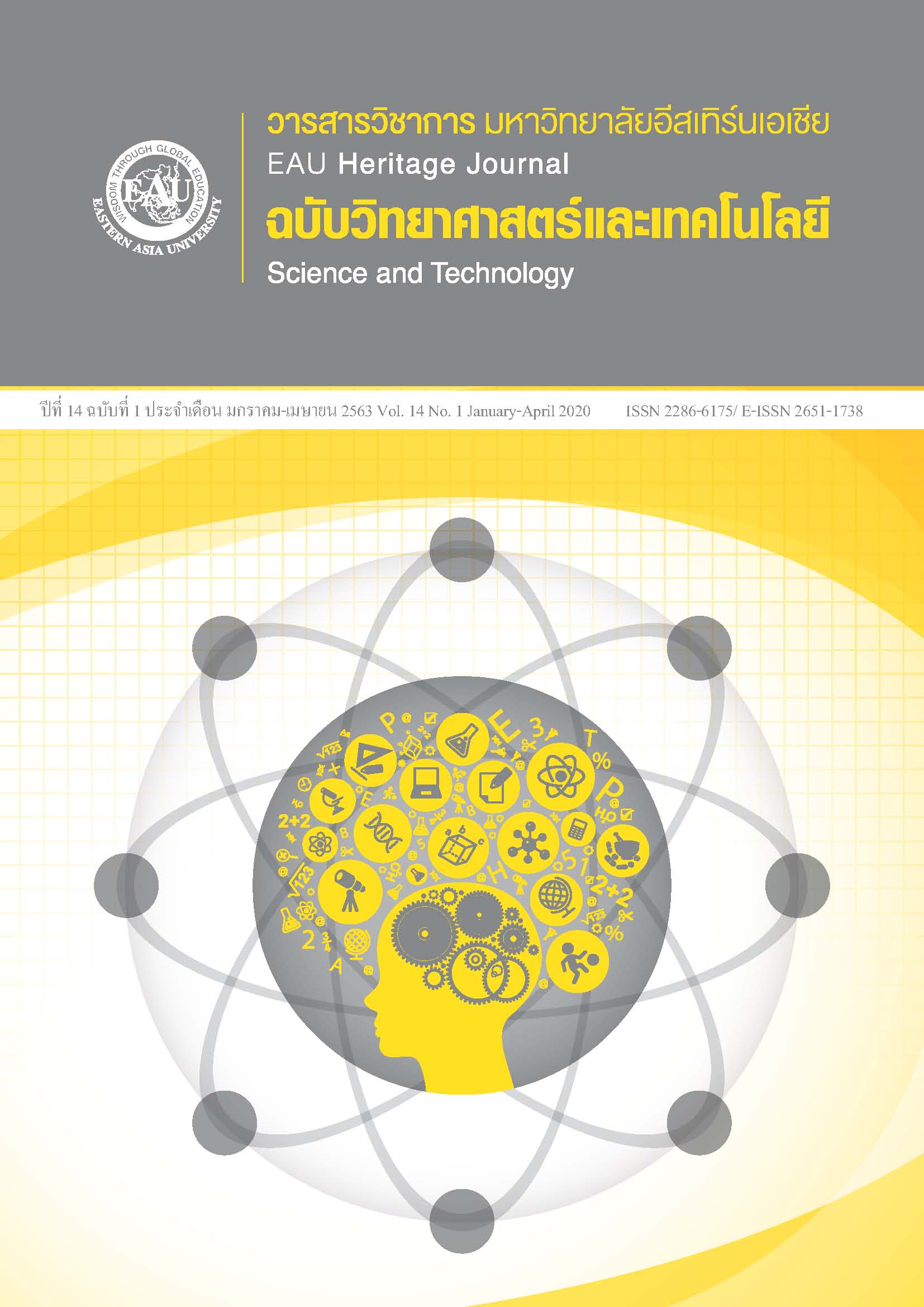การศึกษาปัจจัยที่มีผลต่อการตัดสินใจเข้าศึกษาที่มหาวิทยาลัยราชภัฏเพชรบูรณ์ ด้วยเทคนิคเหมืองข้อมูล
คำสำคัญ:
เหมืองข้อมูล, โครงข่ายประสาทเทียม, ต้นไม้ตัดสินใจ, การเลือกคุณลักษณะ, วิทยาศาสตร์ข้อมูลบทคัดย่อ
งานวิจัยนี้ศึกษาปัจจัยที่มีผลต่อการตัดสินใจเข้าศึกษาต่อที่มหาวิทยาลัยราชภัฎเพชรบูรณ์ของนักศึกษาด้วยเทคนิคเหมืองข้อมูล โดยได้ทำการเก็บข้อมูลจากแบบสอบถาม 14 คุณลักษณะจากนักศึกษาจำนวน 400 คน แบ่งเป็นนักศึกษาใหม่ของมหาวิทยาลัยราชภัฏเพชรบูรณ์ จำนวน 200 คน และอีก 200 คน เป็นนักศึกษาใหม่จากสถาบันอื่น ข้อมูลที่ได้จะถูกนำมาวิเคราะห์ความแตกต่างของคุณลักษณะเบื้องต้น โดยใช้เทคนิคโครงข่ายประสาทเทียม (Artificial Neural Network--ANN) และเทคนิคต้นไม้ตัดสินใจ (decision tree) เพื่อจำแนกข้อมูล ซึ่งมีวิธีการวัดความแม่นยำในการจำแนกจากค่าประสิทธิภาพของโมเดลด้วยการตรวจสอบไขว้จากการแบ่งข้อมูลออกเป็น 10 ส่วน (10-fold cross validation) และค่า RMSE (Root Mean Squared Error) หลังจากได้ผลการวิเคราะห์เบื้องต้นแล้ว ในงานวิจัยนี้จะใช้เทคนิคการคัดเลือกคุณลักษณะของข้อมูลด้วย filter ranker method แสดงผลและอธิบายด้วยแผนภาพต้นไม้ตัดสินใจและกฎ IF-THEN ผลการวิจัยพบว่า การจำแนกนักศึกษาออกเป็น 2 กลุ่ม คือ (1) กลุ่มนักศึกษาใหม่ของมหาวิทยาลัยราชภัฏเพชรบูรณ์ (2) กลุ่มนักศึกษาใหม่จากสถาบันอื่น ด้วยเทคนิคโครงข่ายประสาทเทียมและเทคนิคต้นไม้ตัดสินใจ มีค่าความแม่นยำเป็น 93.00% และ 88.25% ตามลำดับ และมีค่า RMSE เป็น 0.2574 และ 0.3031 ตามลำดับ คุณลักษณะที่เป็นปัจจัยสำคัญที่มีผลต่อการตัดสินใจของนักศึกษาได้แก่ ชื่อเสียงของมหาวิทยาลัย รายได้ของผู้ปกครอง จำนวนหลักสูตร ที่ตั้งของมหาวิทยาลัย อาชีพของผู้ปกครอง และความทันสมัยของหลักสูตร ตามลำดับ ผลการวิจัยนี้แสดงให้เห็นว่าเทคนิคเหมืองข้อมูลมีประโยชน์ในการจัดการข้อมูลและให้ข้อมูลที่มีความหมายที่สามารถใช้เป็นข้อมูลในการพิจารณาหาวิธีการเพิ่มจำนวนนักศึกษาของมหาวิทยาลัยได้
เอกสารอ้างอิง
References
Ahmad, M.W., Mourshed, M., & Rezgui, Y. (2017). Trees vs neurons: Comparison between random forest and ANN for high-resolution prediction of building energy consumption. Energy and Buildings, 147(1), 77-89.
Ahmed, A.M., Rizaner, A., & Ulusoy, A.H. (2016). Using data mining to predict instructor performance. Procedia Computer Science, 102(1), 137-142.
Angeli, C., Howard, S.K., Ma, J., & Yang, J. (2017). Data mining in educational technology classroom research: Can it make a contribution? Computer & Education, 113(1), 226-242.
Deng, W.J., Chen, W.C., & Pei, W. (2008). Back-propagation neural network based importance-performance analysis for determining critical service attributes. Expert Systems with Applications, 34(2), 1115-1125.
Han, J., & Kamber, M. (2006). Data mining: Concepts and techniques. San Francisco: Morgan Kaufmann Publishers
Hsu, C.H. (2009). Data mining improve industrial standards and enhance production and marketing: An empirical study in apparel industry. Expert Systems with Applications, 36(3), 4185-4191.
Ippoodom, T. (2017). Thai university crisis when the educational institutions wage a war for students to survive. Retrieved from https://thematter.co/pulse/war-of-thai-university/25611
Jones, D.E., Ghandehari, H., & Facelli, J.C. (2016). A review of the applications of data mining and machine learning for the prediction of biomedical properties of nanoparticles. Computer Methods and Programs in Biomedicine, 132(1), 93-103.
Jothi, N., Rashid, N.A.A., & Husain, W. (2015). Data mining in Healthcare–A Review. Procedia Computer Science, 72(1), 306-313.
Kaur, P., Singh, M., & Josan, G.S. (2015). Classification and prediction based data mining algorithms to predict slow learners in education sector. Procedia Computer Science, 57(1), 500-508.
Liao, S.H., Chu, P.H., & Hsiao, P.Y. (2012). Data mining techniques and applications: A-decade review from 2000 to 2011. Expert Systems with Applications, 39(12), 11303-11311.
Lou, W., & Nakai, S. (2001). Application of artificial neural networks for predicting the thermal inactivation of bacteria: A combined effect of temperature, pH and water activity. Food Research International, 34(7), 573-579.
Lui, X., Li, Q., Li, T., & Chen, D. (2018). Differentially private classification with decision tree ensemble. Applied Soft Computing, 62, 807-816.
Natek, S., & Zwilling, M. (2014). Student data mining solution-knowledge management system related to Higher Education Institutions. Expert Systems with Applications, 41(14), 6400-6407.
Ozyirmidokuz, E.K., Uyar, K., & Ozyirmidokuz, M.H. (2015). A data mining based approach to a firm’s marketing channel. Procedia Economics and Finance, 27, 77-84.
Packianather, M.S., Davies, A., Harraden, S., Soman, S., & White, J. (2017). Data mining techniques applied to a manufacturing SME. Procedia CIRP, 62(1), 123-128.
Panto, O., & Theantong, M. (2014). A comparative efficiency of classification of VARK learning style using data mining techniques. Journal of Industrial Technology Ubon Ratchathani Rajabhat University, 4(1), 1-11. (in Thai)
Phang, S.L. (2012). Factors influencing international students’ study destination decision abroad. Master of Communication Thesis, University of Gothenburg.
Pu, Y., Apel, D.B., & Lingga, B. (2018). Rockburst prediction in kimberlite using decision tree with incomplete data. Journal of Sustainable Mining, 17(3), 158-165.
Rodrigues, M.W., Isotani, S., & Zarate, L.E. (2018). Educational data mining: A review of evaluation process in the e-learning. Telematics and Informatics, 35(6), 1701-1717.
Schmitz, GJ., Aldrich, C., & Gouws, F.S. (1999). ANN-DT: An algorithm for extraction of decision trees from artificial neural networks. IEEE Transactions on Neural Networks, 10(6), 1392-401.
Sen, B., & Ucar, E. (2012). Evaluating the achievements of computer engineering department of distance education students with data mining methods. Procedia Technology, 1(1), 262-267.
Sen, B., Ucar, E., & Delen, D. (2012). Predicting and analyzing secondary education placement-test scores: A data mining approach. Expert Systems with Applications, 39(10), 9468-9476.
Sittichat, S. (2017). Study of educational attributes using data mining technique. Information Technology Journal, 13(2), 20-28. (in Thai)
Ramaswami, M., & Bhaskaran, R. (2009). A study on feature selection techniques in educational data mining. Journal of Computing, 1(1), 7-11.
Timsorn, K., Lorjaroenphon, Y., & Wongchoosuk, C. (2017). Identification of adulteration in uncooked Jasmine Rice by a portable low-cost artificial olfactory system. Measurement, 108(1), 67-76.
Timsorn, K., Thoopboochagorn, T., Lertwattanasakul, N., & Wongchoosuk, C. (2016). Evaluation of bacterial population on chicken meats using a briefcase electronic nose. Biosystems Engineering, 151(1), 116-125.
Tsai, Y.C., Trang, L.T., & Kobori, K. (2017). Factors influencing international students to study at universities in Taiwan. International Journal for Innovation Education and Research, 5(1), 1-11.







